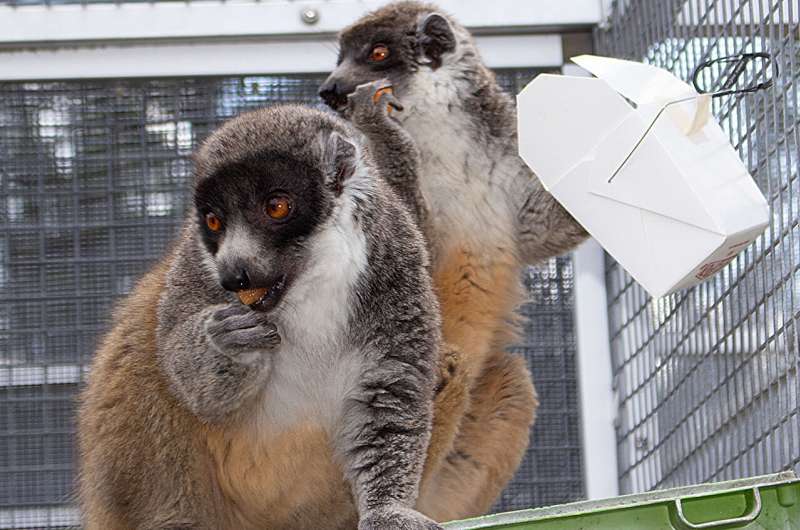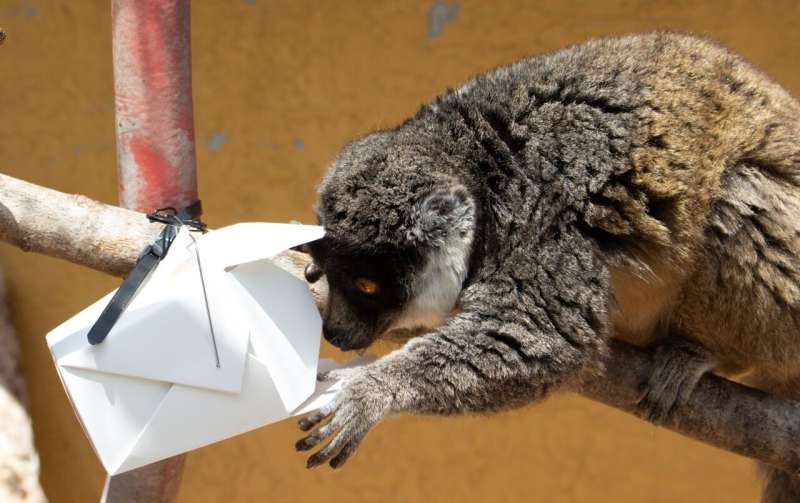This article has been reviewed according to Science X's editorial process and policies. Editors have highlighted the following attributes while ensuring the content's credibility:
fact-checked
peer-reviewed publication
trusted source
proofread
Lemurs use long-term memory, smell, and social cues to find food

How do foraging animals find their food? A new study by New York University researchers shows that lemurs use smell, social cues, and long-term memory to locate hidden fruit—a combination of factors that may have deep evolutionary roots.
"Our study provides evidence that lemurs can integrate sensory information with ecological and social knowledge, which demonstrates their ability to consider multiple aspects of a problem," said anthropologist Elena Cunningham, a clinical professor of molecular pathobiology at NYU College of Dentistry and the lead author of the study, published in the International Journal of Primatology.
Animals rely on their senses and environmental and social knowledge to locate food and water. These factors—perhaps in combination—are thought to have played a role in primates evolving to have larger brains and higher cognitive abilities than other animals.
"Historically, there have been two schools of thought on why primates developed bigger brains: ecological pressures, such as needing to find scarce fruit in the forest, and the social pressures of living in a group where everyone is trying to outsmart one another," said Cunningham. "I have long been interested in the interplay between social and ecological factors when it comes to cognition—it seems like a given that these would have evolved in relation to each other."
To better understand how primates integrate these factors in order to find food, Cunningham traveled to the Lemur Conservation Foundation in Myakka City, Florida, a reserve dedicated to researching and protecting lemurs outside of their native Madagascar. The Foundation is home to several lemur species, including brown lemurs—social animals who have a keen sense of smell (far better than humans) and whose diet is primarily fruit.

Studying the brown lemurs in pairs and groups of three, the researchers conducted several experiments by hiding pieces of cantaloupe in cardboard takeout containers and placing both fruit-filled and empty containers in the lemurs' environments. They then observed how the groups of lemurs investigated and opened the containers, noting their interactions with one another.
Despite the empty takeout containers outnumbering the ones with cantaloupe, the lemurs had little trouble finding and eating the fruit—and several factors appeared to be working in tandem. The lemurs quickly learned which containers had food in them, and could remember the location of the fruit-filled containers days, weeks, and even months later: the order in which they approached baited containers was about 50 percent better than chance. But, the lemurs almost always (98 percent of the time) opened the fruit-filled containers first, suggesting that they used their sense of smell to detect the cantaloupe at close range.
In addition, the researchers observed that the lemurs' individual strategies for finding fruit were influenced by social factors. Some groups were egalitarian and information and melon were willingly shared, while in other more hierarchical groups, the dominant lemurs took advantage of the subordinates discovering the cantaloupe and helped themselves once the fruit was found. But the subordinates were more likely to find the fruit and some used their "finder's advantage" to eat more of the melon.
"What our study shows is that these three factors are all operating at the same time—the lemurs have memories of where the food is and they are considering olfactory information and social factors," said Cunningham. "We still have much to learn about how this interplay and the evolution of cognition, but it's important to look at these factors not in isolation, but in conversation."
Additional study authors include Malvin Janal, Rachelle Wolk, and Maria Gonzalez-Robles of NYU Dentistry.
More information: Elena P. Cunningham et al, Brown Lemur (Eulemur spp.) Use of Olfaction, Memory, and Social Strategies to Obtain Cantaloupe, International Journal of Primatology (2024). DOI: 10.1007/s10764-024-00448-0
Journal information: International Journal of Primatology
Provided by New York University



















